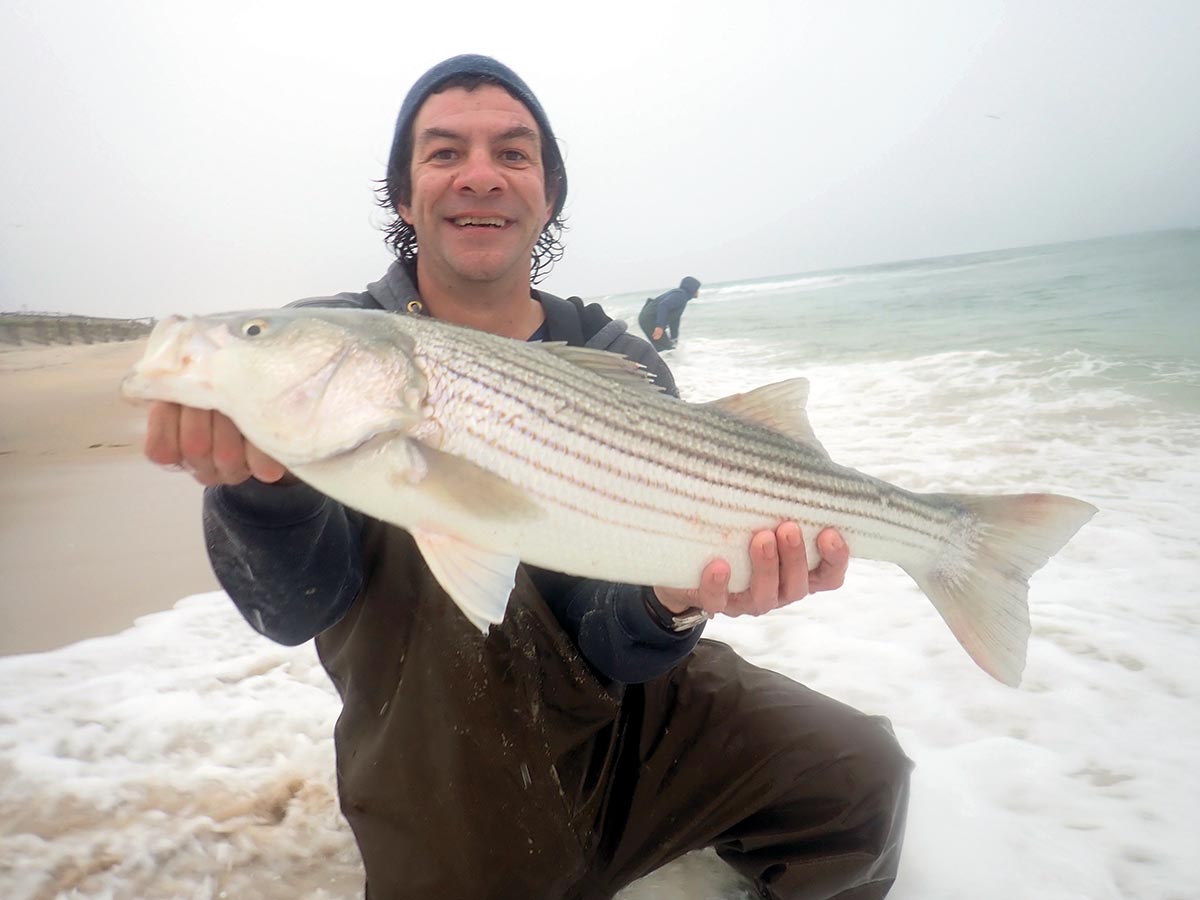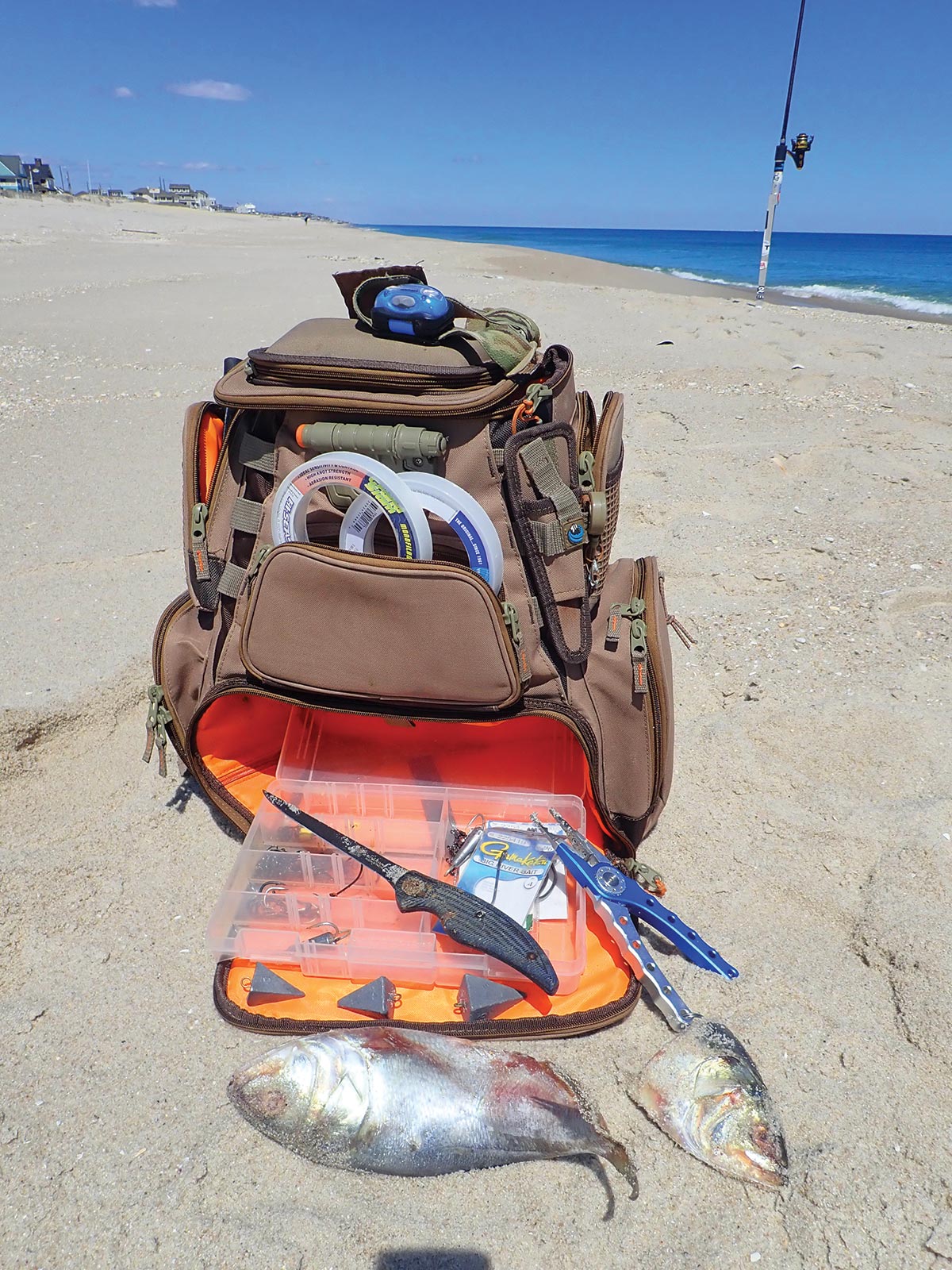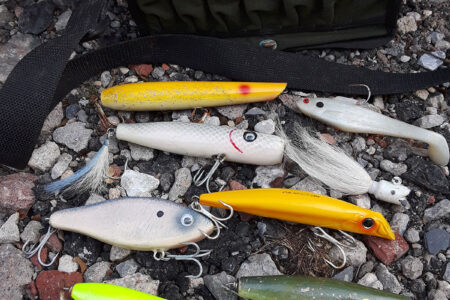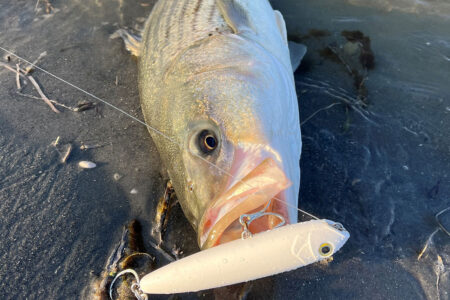
Those bass are moving north this month; don’t miss your chance to chunk up a good one.
Bait slingers. Ugh right? Who throws bait? Only those shiny custom wooden plugs can catch 40-pound bass and 20-pound blues, right? Yeah, wrong. Bunker chunking is a lost art that has fallen by the wayside with the righteous advent of plug-crazy hound dogs in the late 2000s. Don’t get me wrong, I thoroughly enjoy catching bass and blues on plugs, but there’s something about the hit from true fresh bunker chunking that puts a straight up lightning strike through my body.
All through June, remnant and resident cow bass up to 40 pounds hang tight in the suds, while gator blues from 6 to 20 pounds can be cruising and bruising all month long, day and night. The central coast stretch from Manasquan to Island Beach State Park is ripe with spring activity, so here’s how to line yourself up for success on the chunk.
Slide Rigs
When the surf is relatively calm, say flat to 3 feet, it’s prime time to use slide rigs. The prevailing theory of a slide rig is to allow the bait to be inhaled unhindered by any additional weight of the sinker so the fish takes the food and runs off free like nothing is attached. Calmer surf won’t flop the slide rig around to tangle upon itself, as compared to roiling churny waters where the rig can’t get out of its own way. My slider rig works like this – a braid friendly nylon fishfinder slide clip, 75-pound Spro barrel swivel, 24-inch section of 40- to 60-pound Seaguar fluorocarbon leader and size 9/0 to 10/0 octopus circle Gamakatsu hook. On slide rigs, set your drag a little looser to let the fish pick the bait, then reel against the fish for a quick hookset on a circle hook.
Rooted Rigs
Rougher surf of 3 feet plus demands anchored rigs such as hi-lo or three-way swivel rigs that set relatively stationary in the sand, not flopping around on itself, where a slide rig will flop and tangle up in the braid and in the leader. Hi-lo rigs are comprised of 40-pound TrikFish leader, starting with a 75-pound Spro barrel swivel, 12 inches down to a dropper loop and 6/0 baitholder hook, 12 more inches down with another dropper and hook, then 5 inches down from there an overhand knot for the pyramid sinker weight of 3 to 6 ounces. A three-way rig consists of a size #1 three-way swivel, clip a 3- to 5-ounce pyramid sinker, to the third eye, a 30-inch section of 40- to 60-pound Trikfish or Seaguar fluorocarbon leader. If specifically targeting blues, do not use brightly shining silver three-way swivels as the blues will hit the shiny terminal tackle and cut off rigs. Use black matte colored terminal gear.
Tides & Moons
Striped bass and blues tend to move in thick during fuller tides where there is more water on the move. Incoming has seen better action in recent years, as well as the start of the outgoing. Prime times to fish in June are three days before and after the new (June 3) and full (June 17) moons where flood tides high revolve around the 6 to 10 o’clock time frame (Around Central and Northern Jersey oceanside beaches, the day of a full or new moon, the high tide is always around 8 a.m. or 8 p.m.) Two hours before the dead high to two hours after is also a prime time to set up on the chunk, regardless if it’s morning or mid-day, but don’t overlook a dead low tide in the morning hours as you can wade out on the skinny water bar and launch a cast way into the Atlantic.
Bass Conditions
Stripers are generally early risers. Plan outings around predawn and sunup hours, matched with easterly or northeasterly type winds, or a west wind offshore clean-up after a blow. Look for that green, clean whitewater. When it gets a little dirty, that’s generally okay; but when it’s more brown than green the bite typically starts shutting down. Rougher surf usually fires up the bass to bite, so long as it’s not a brown hurricane washing machine type of conditions. And don’t overlook the dark hours. Some of the most productive bass outings revolve around night time chunking with big bunker heads, lobbing out in the deep cuts and sloughs. Many times punishing hits come right in the undertow where bass can freely and comfortably peruse the slough under the guise of darkness. While sections of bunker work well, don’t overlook the bunker head for bass; you may not get as many hits but the ones you get are sure to be huge.
Bluefish Conditions
Churned and rough or flat like a lake, all conditions can attract blues, depending on the time of year. Summer conditions will generally consist of flat, clear blue water and sunny bright bluebird skies. Clean clear waters are fine, as are riled up green washing machine whitewater days up to 5-footers. Southeast winds usually mean a warm front moving up, and I always have luck with the southeasterly or easterly winds. Night time is also plenty fine for chunking blues; actually it’s even better as there are no sunbathers on the beach at that time, you can chum the waters with bunker oil and douse your baits in the oil to create a virtual chum slick to bring the blues in. Fresh bunker is cut in chunks, hook baits through the fatback. Bring clip on Cyalume light sticks on the rod tips and heavy duty metal Anglers Mate shovel type sand spikes as hammering hits from blues can and will take the rod set up into the water to be forever lost to the sea.

The Set Up
I always go big when chunking, expecting to land trophy fish and never wanting to be undermatched. Thus, two rods I use are 12-foot Tsunami STIISC1202XH and 12-foot Shimano TRS120MHA matched with a Shimano Ultegra 14000; of course you can always do with the battle wagon Penn Slammer 8500 SS series reels. Spool up with 50-pound Power Pro braided line. Bring leader material ranging from 40- to 80-pound, depending on whether the alligator blues with big chopping maws are around or not, and utilize Seaguar fluorocarbon leader if specifically shooting for stripers. Leave the dinky white PVC sand spikes at home and invest in the 3-foot metal shovel foot bar sand spikes from Anglers Mate that can be foot-pushed into the ground to ensure a solid anchor to which plant your rod.
Proving Grounds
There are many areas along the northern and central Jersey sands to try your chunking game. A few favorites include the Sandy Hooks shoreline, Monmouth Beach, along the Asbury Park jetties, Spring Lake jetties, Manasquan and Point Pleasant pockets, Brick Beaches, Lavallette, Seaside Park and IBSP, the jetty at Barnegat Light, Ship Bottom and Holgate suds; these central and norther region spots all hold deeper waters and swashy grounds that attract both bass and blues. Pick your spot according to the cuts, sloughs, holes and water clarity on any given day and pay attention to reports in The Fisherman, especially the Beach Talk section which I write, to dial you into the most up to date intel. If you want excitement, get on the chunk. The visuals of the rod bending to the horizon with a colossal fish peeling off drag is sure to get your juices flowing.
As a side note, I release 99 percent of the bass and blues I catch, unless a fish has little to no chance of survival. I also enjoy bringing home a bass to cook or bluefish to smoke every now and then. To each their own. But whatever you do retain legally, think about how much you will actually eat and how much will get freezer-burned and thrown out.




